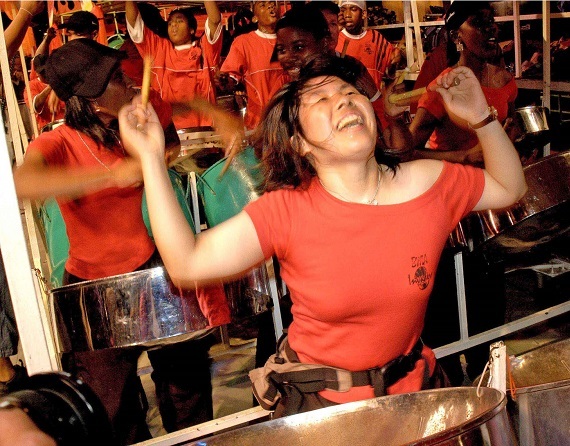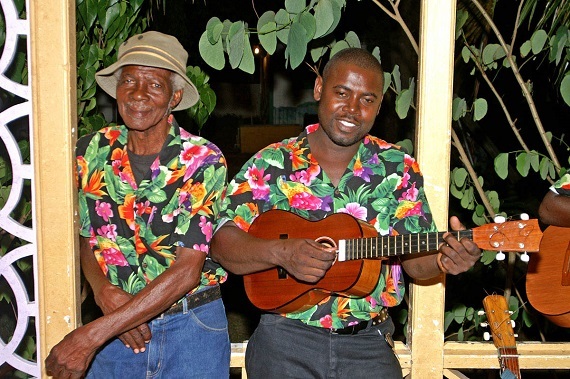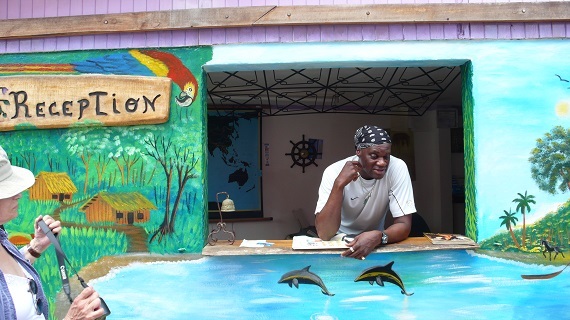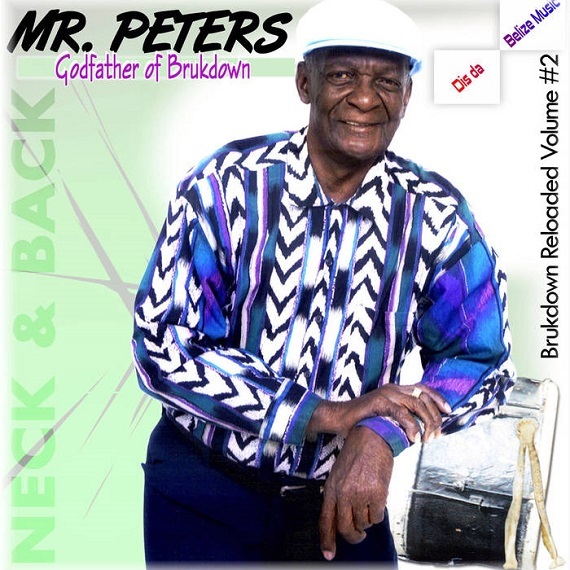Don't get me wrong. I love Jamaican reggae music. Ditto for its two predecessors, rocksteady and ska, and before that mento and old-time calypso. But down in the Caribbean you'll hear all kinds of other booty-shaking rhythms -- mostly tracing their way back to Africa by way of the slaves brought here to work the plantations and mills -- depending on what island you're on.

Steel panners get a workout. Photo courtesy of Republic of Trinidad and Tobago Ministry of Tourism/Jim Stephens.
Let's start at the northern end of the islands, on the Bahamas. You'll get pumped up here by brassy New Orleans parade-like junkanoo music (spiced up by cowbells, scratch sticks and Trinidadian steel drums). Next, a little south, you'll find bands blasting out world-class salsa all over Cuba among lots of other local rhythms like son, guajira and pachanga.
Fly an hour or so east, and you'll touch down on the island of Hispaniola. On the Haitian side you might find yourself gyrating a bit to the local folks' sensual, heavy-on-the-drums compas tunes. But things get a lot peppier on the larger part of the island in the Dominican Republic -- the home of a sexy beat called merengue and an even sexier one, bachata.
Local governments tried (unsuccessfully) to ban both kinds of music over the years. Merengue became legit in 1930 when dictator Rafael Trujillo gave it the green light (after a questionable election in which he registered an improbable 95 percent of the votes). Bachata has never officially become kosher (but no one's going to throw you in the pokey for dancing it).
Go a little further east, shut your eyes, and you'll think you're back (musically) on Cuba. Only now you'll be on the U.S. Territory of Puerto Rico. Keep going east to another of Uncle Sam's territories, the U.S. Virgin Islands, and you'll hear everything from local quelbe tushy-shakers to minuet-like quadrilles (a hangover from the islands' former owners, the Danes, who sold them to the U.S. in 1917).
Edging the U.S. Virgins (tagged by Christopher Columbus after the legendary 11,000 virgin handmaidens of St. Ursula) are the British Virgin Islands, where banjo-backed funji music rules.
From there our musical journey turns south, zipping over dozens of islands dotting the blue-green waters of the Caribbean for some 550 miles from the British Territory of Anguilla down the chains of the Leeward and Windward Islands to Trinidad-Tobago. Along the way, among the peppiest and/or sexiest rhythms are: zouk (a brassy contender for the most sexiest) from French-speaking islands like Martinique and Guadeloupe; jwe from St. Lucia; spouge from Barbados; big drum (using drums typically made from rum kegs) from St. Vincent and the Grenadines; and a mish-mash of zouk, calypso and reggae from Grenada.
At the southern end of the Windward chain is the Caribbean's musical powerhouse of Trinidad-Tobago (T&T for short), the home of countless old-time calypso counts, kings, lords and dukes. From an earlier T&T creation, "panners" are still batting out tales of Mary Ann sifting sand all day and all night on steel drums (first fashioned out of 55-gallon oil drums here in the 1930s). More recently, Trinidad gave birth to soca (a blend of soul and calypso and hands-down the loudest, twerkiest music of the Caribbean), today heard all over the islands.
After a westward hop to the "A-B-C" (Aruba-Bonair-Curacao) islands for a little tumba dancing we wrap up our musical journey on the powdery sands of two Central American countries on the Caribbean rim.
First is the "Calypso Coast" of Costa Rica, a 55-mile-long stretch running from Puerto Limon down to the Panamanian border. Here, thanks to the legacy of thousands of Jamaican laborers imported in the late 1800s to build a railroad through the jungle (and who when it was finished decided not to go home) you'll hear vintage calypsos wafting through the air at little towns dotting the coast. Stop at some, belt down a few local Bavaria beers and you might spot Harry Belafonte sitting on a dock in striped clamdigger pants telling tales of how a lady named Matilda took his money and ran off to Venezuela.
Finally, if you like accordion-backed cajun music from the bayous of Louisiana, chances are you'll go bonkers over brukdown from the beaches of Belize (up three countries from Costa Rica). Arguably the catchiest of all the Caribbean rhythms, brukdown -- slang for broken down calypso -- rules the roost around these parts (think cajun zydeco with a tropical twist). Its guru was Wilfred Peters, aka Mr. Peters, who for 60 years until he died in 2010 was -- and still is -- the soul of brukdown.
A sort of Belizean Bob Marley, Peters may be best remembered for his cheery wake-up song "Good Mawnin' Belize," heard on the radio each morning in homes across the country.
You can learn much more about Caribbean music in a package of three CDs called Africa en America. Forty ethnic songs from 19 countries in and edging the Caribbean are offered on the discs along with a brochure that tells you where each of the rhythms orginated in Africa, and even the history of the instruments.



